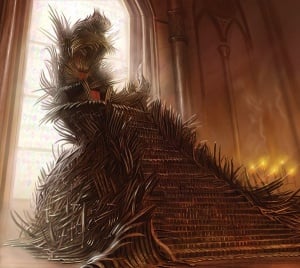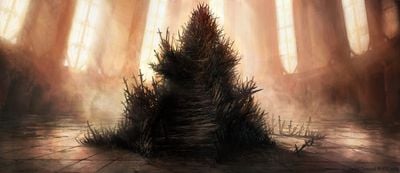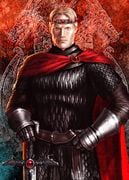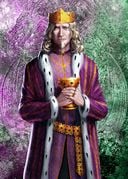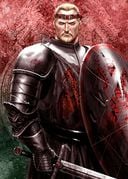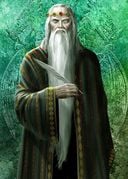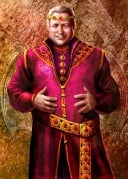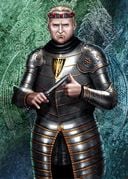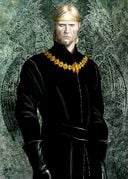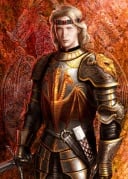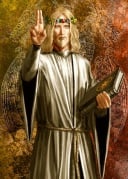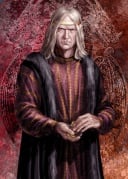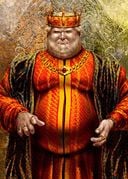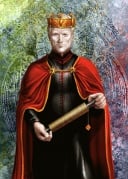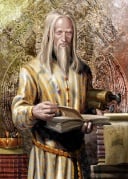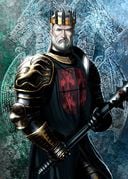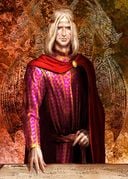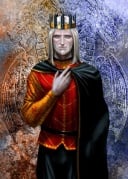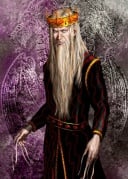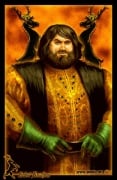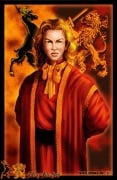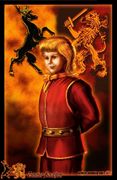Iron Throne
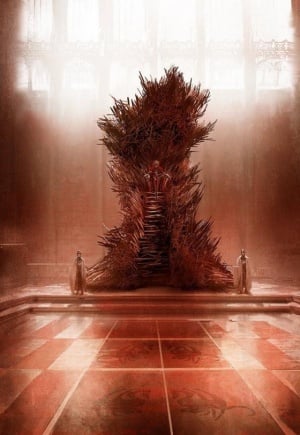
The Iron Throne is the seat of the Lord of the Seven Kingdoms, and is often used as a metonymic device to refer to the authority of the King of the Andals, the Rhoynar, and the First Men or to the polity born after Aegon's Conquest. The king often holds audiences and dispenses justice from atop it in the Red Keep's throne room, the Great Hall.[2] The chair is cold and hard, with many jagged edges.[3]
Contents
Customs
In the king's absence, only his Hand may sit on the throne. Such privilege does not extend to royal regents.[4] However, three exceptions exist: Queen Rhaenys Targaryen and Queen Visenya Targaryen, who were King Aegon I Targaryen's partners in power;[5] and Queen Rhaenyra Targaryen, who sat the throne when she took King's Landing during the Dance of the Dragons.[6]
Appearance
- See also: Images of the Iron Throne
The Iron Throne is an asymmetric monstrosity of spikes and jagged edges and twisted metal.[7] The throne was constructed by Aegon I Targaryen from the melted, twisted, beaten, and broken blades surrendered by his enemies,[8][9] or wrenched from the hands of the dying.[1] According to the songs, it took a thousand blades to make.[7] George R. R. Martin has described the Iron Throne as "massive", "ugly", and "asymmetric".[1] The throne is a symbol of conquest.[1]
The Iron Throne is located on a high platform in the throne room within the Red Keep.[7] It can be reached by climbing steep iron steps[7] in the Great Hall,[2] and the small council has a table at the base of the throne.[7]
Because of the fanged steel behind, it is impossible to lean back on the iron seat of the Iron Throne. Aegon I intended for it to be uncomfortable, believing that "a king should never sit easy".[7] The points of the twisted blades fan out like talons from arms of the throne. Even after three hundred years, some of the blades are still sharp enough to cut.[7]
The Iron Throne is known for being dangerous to its occupants. King Viserys I Targaryen cut his left hand to the bone after stumbling, and Maester Gerardys had to remove two fingers to save his life.[10] According to Septon Eustace, an armor-clad Queen Rhaenyra Targaryen was seen with cuts on her legs and left hand after sitting the throne for the first time, which led some to believe she had been rejected by it.[6] King Aerys II Targaryen was cut so many times that he became known as "King Scab".[11][12]
According to the stories, the Iron Throne is capable of killing a person, and has done so before.[7] King Maegor I Targaryen, for instance, was found dead on the Iron Throne, his arms slashed open from wrist to elbow on jagged barbs, and with a blade through his neck, emerging beneath his chin. Although various culprits have been considered as having possibly murdered Maegor the Cruel, many still believe the king had been killed by the throne itself.[13]
History
Aegon the Conqueror

Following his conquest of six of the Seven Kingdoms in Westeros, Aegon I Targaryen proclaimed himself their king, and was crowned by the High Septon at Oldtown.[9] From the swords of his enemies, Aegon created the Iron Throne, and the dynasty he began would rule for nearly three hundred years.[9][7] According to the songs, the throne was constructed with a thousand blades, heated by the dragonflame of Balerion, Aegon's dragon.[7] According to history, however, the throne was forged by armorers.[7]
The Iron Throne stood at Aegon's wooden castle, the Aegonfort, which was located at the place where he had first come to shore. The town that grew around it became King's Landing, the kingdom's new capital.[9][14] Aegon reconciled the Iron Islands under his rule in 2 AC, and continued his wars in 4 AC with the First Dornish War, in an attempt to subdue the seventh of the Westerosi kingdoms.[15]
The Iron Throne kept out of war following the conclusion of the First Dornish War in 13 AC.[15] Other wars with Dorne would follow under Aegon's successors: the Second Dornish War in 37 AC at the start of Aenys I Targaryen's reign, the Third and Fourth Dornish War during the reign of Jaehaerys I Targaryen,[16] and the Conquest of Dorne during the reign of Daeron I Targaryen.[17]
During Aegon's reign, one of his queens Rhaenys and Visenya Targaryen would sit on the Iron Throne while Aegon and his other sister were away from the capital for one of his progresses.[5] In 35 AC, Aegon had the Aegonfort where the Iron Throne stood torn down.[18] As construction of the Red Keep began, the Iron Throne remained where it had stood.[13]
Aenys I and Maegor I

Aegon's immediate successor, his eldest son Aenys I, faced several rebellions at the start of his reign in 37 AC, which were resolved by his bannermen and brother, Prince Maegor, during the course of the year. Aenys later faced problems with the Faith of the Seven, first following his brother's polygamous marriage in 39 AC, and next after he married his son and daughter, Aegon and Rhaena, to one another in 40 AC. The Faith rose in rebellion against the Iron Throne, eventually forcing Aenys and his family to flee King's Landing for Dragonstone. Aenys died the following year of illness.[19][13]
Aenys's brother Maegor returned from his exile and claimed the throne over the late king's eldest son, Prince Aegon, who was unable to travel to King's Landing. While Maegor took the throne, Dowager Queen Alyssa Velaryon proclaimed Aegon king on Driftmark, but few came forth to support him. Called "the pretender" and "Aegon the Uncrowned", Aegon took up arms against Maegor in 43 AC after he slipped into the capital to claim the dragon Quicksilver. Aegon fell to Maegor during the Battle Beneath the Gods Eye later that year, however.
During his six-year rule, Maegor continued to fight the Faith and did so harshly, causing the deaths of thousands. Notably, he ordered the construction of Maegor's Holdfast within the Red Keep in 43 AC. The Red Keep was completed in 45 AC, after which Maegor had all the workers killed to prevent the castle's secrets being spread.[13][20] Aenys I's youngest son, Prince Jaehaerys, announced his claim to the throne at Storm's End early on in 48 AC. Maegor's main supporters flocked to Jaehaerys's side, leaving him with insufficient men to defend himself. Maegor was found dead seated on the Iron Throne by Queen Elinor Costayne hours after his last war council. The cause of Maegor's death is still debated; several potential murderers have been put forth, with some suggesting that Maegor had been killed by the throne, and others that Maegor had taken his own life.[13][11][20]
Jaehaerys I and Viserys I
Following his death, Maegor I was succeeded by his brother's youngest son, Jaehaerys I Targaryen. Jaehaerys reigned for fifty-five years.[21] He recognized first his sister's eldest daughter Aerea Targaryen as his heir,[22][23] followed by his own daughter Daenerys[24] and later his son Aemon.[25] Aemon's death in 92 AC resulted in a crisis in the line of succession, forcing Jaehaerys to choose between Aemon's daughter and only child, Rhaenys, and his own second son, Baelon. When Baelon was named, the pregnant Rhaenys proclaimed that the king had not only passed over her, but also her "unborn son". Upon Baelon's death in 101 AC, Jaehaerys called the first Great Council at Harrenhal, to appoint his new heir. For thirteen days, the fourteen claims were discussed by the lords of the realm. The lords assembled eventually chose between Rhaenys's son Laenor Velaryon and Baelon's eldest son Viserys. The elder Viserys was chosen with the great majority of the votes.[10]
Viserys's reign gave peace and plenty to the realm. In 126 AC, after passing judgement seated on the Iron Throne, Viserys injured himself severely on the barbs. Maester Gerardys managed to save the king's life. The amputation of two of Viserys's fingers, [26] Following the death of his second son, Prince Baelon, Viserys officially proclaimed his daughter, Princess Rhaenyra, as his heir. Viserys remarried after the death of his first wife, but despite having three sons during his second marriage, he continued to view Rhaenyra as his heir.[10]
The Dance and Regency
At Viserys I's death in early 129 AC, Aegon the Elder, his eldest son, claimed the throne, making use of Rhaenyra Targaryen's presence at Dragonstone during her pregnancy. Brother and sister fought over the throne during the two and a half years that followed, a struggle called the Dance of the Dragons. In 130 AC, Rhaenyra took King's Landing and sat the first night on the Iron Throne to accept fealty from those present at the Red Keep. Even though Rhaenyra wore armor at that time, Septon Eustace, one of the supporters of Aegon II, claims that Rhaenyra had cuts on her legs and the palm of her left hand once she got up from the throne. Eustace claimed this was an indication that "the Iron Throne had spurned her".[6]
Once Rhaenyra fled King's Landing half a year later after the Storming of the Dragonpit, two new "kings" declared themselves during the Moon of the Three Kings: Trystane Truefyre, a young squire who took possession of the Red Keep and sat on the Iron Throne, and Gaemon Palehair, a small child.[27] Aegon II fed Rhaenyra to his dragon, Sunfyre, after the fall of Dragonstone. Trystane and Gaemon were eventually arrested by Lord Borros Baratheon. Since Aegon was away at Dragonstone, the Dowager Queen Alicent Hightower received the submission of Lord Corlys Velaryon from the lower steps of the Iron Throne.[28]
The crippled Aegon was unable to climb the steps of the Iron Throne when he returned to the capital, so he instead used a carved and cushioned wooden seat below.[28] Aegon was killed with poison half a year later after the Battle of the Kingsroad,[28] and his body was laid upon a bier by the Iron Throne when the Lads arrived at the Red Keep.[29] Rhaenyra's eleven year-old son, Aegon the Younger, was crowned king, and married to Aegon II's daughter and only remaining child, Jaehaera Targaryen, uniting the claims.[30] Lord Cregan Stark briefly served as Hand of the King during the so-called Hour of the Wolf. Although Cregan might have sat the Iron Throne as Hand, he instead used a simple wooden bench beneath it.[29]
When Lord Corlys Velaryon died in 132 AC during the regency of Aegon III, his body was placed beneath the Iron Throne for seven days.[31] Unlike Cregan Stark, Lord Unwin Peake used the Iron Throne while serving as Aegon's Hand.[32] Aegon sat on the throne during the Maiden's Day Ball.[32]
Daeron I, Baelor I, and Viserys II
Aegon III Targaryen was succeeded in 157 AC by his fourteen-year old son, Daeron, who led the conquest of Dorne. The Young Dragon was slain by Dornishmen four years later, however, and then succeeded by his brother Baelor I. When Baelor the Blessed died in 171 AC after a forty-day fast,[33] the succession of the Iron Throne was again unclear. The claims of Baelor's three sisters were discussed, but dismissed, after which Baelor's uncle, Viserys II Targaryen, was crowned. Viserys reigned for only a year, but it said he truly ruled and preserved the land for much longer, as he had been Hand of the King during the time of his brother Aegon III's reign, as well as the reigns of his nephews Daeron and Baelor. Despite the shortness of his reign, Viserys implemented several new reforms.[34]
Daeron II and Daemon Blackfyre
After Viserys II Targaryen died of a sudden illness, his eldest son ascended the Iron Throne as Aegon IV, who is remembered in history as "the Unworthy". On his deathbed, Aegon legitimized all of his bastards, including Daemon Blackfyre, his bastard son by his cousin Daena Targaryen. , in which Daemon Blackfyre fought King Daeron II Targaryen for the Iron Throne.[35]
Aegon's heir, King Daeron II Targaryen, brought Dorne peacefully into the realm early on in his reign, by wedding his younger sister Daenerys to his good-brother Maron Martell, the Prince of Dorne.[36] Aegon IV had previously gifted Daemon Blackfyre with the Targaryen sword Blackfyre, typically considered the "sword of kings".[35] This, combined with the growing Dornish influence at court, brought resentment against Daeron II.
In 196 AC, Daemon announced his claim to the Iron Throne, beginning the First Blackfyre Rebellion. When he died during the Battle of the Redgrass Field later that year with his two eldest sons, his remaining children fled to Essos. Four other rebellions would follow in the decades that followed. The second and third rebellions took place during the reign of Aerys I Targaryen,[37] the fourth during the reign of Aegon V Targaryen, [38] and the fifth and final rebellion as part of the War of the Ninepenny Kings during the reign of Jaehaerys II Targaryen. [39]
Later Kings
Following the death of Daeron II Targaryen's eldest son, Baelor, and Baelor's two sons Valarr and Matarys, Daeron was succeeded by his second son, Aerys I Targaryen. The new king's first heir was his brother, Rhaegel.[37] After Rhaegel's death, Aerys acknowledged Rhaegel's only son Aelor as his heir, but Aelor died in 217 AC during a mishap caused by his twin sister and wife, Aelora.[37] Aerys's third heir was Aelora.[40] However, she was mad with grief and committed suicide sometime later, leaving Aerys to recognize his fourth and last heir to the throne, his youngest brother Maekar. When Aerys died in 221 AC, Maekar succeeded him.[37][41]
Maekar I's reign lasted until 233 AC, when the king fell in battle fighting a rebellious lord on the Dornish Marches[41] during the Peake Uprising.[42]
A Great Council was convened after Maekar's death, and his fourth son was chosen as King Aegon V Targaryen.[41] Aegon the Unlikely perished in 259 AC in the tragedy of Summerhall,[38] however, and was succeeded by his second son, Jaehaerys II, who died three years later of illness.[43]
The Mad King
Jaehaerys was followed by his son, Aerys II. Although his reign began promising, Aerys's madness slowly grew. By 280 AC, he had become known as the “Mad King” and “King Scab”, for he had cut himself on the Iron Throne many times.[12]
Following the abduction of Lyanna Stark by Aerys's son, Prince Rhaegar Targaryen, the Mad King executed her father and brother, Lord Rickard Stark and Brandon Stark, in the throne room in 282 AC. Ser Jaime Lannister of the Kingsguard stood at the foot of the Iron throne during the executions.[44] Lord Jon Arryn refused Aerys's order to kill Rickard's heir, Lord Eddard Stark, and Lord Robert Baratheon at the Eyrie, however, beginning Robert's Rebellion against House Targaryen.[45]
The Vale of Arryn, the north, and parts of the stormlands and riverlands rose against Aerys, and the westerlands joined the rebels after Rhaegar's death in the Battle of the Trident. During the Sack of King's Landing by Lord Tywin Lannister's host, the Mad King ordered his pyromancers to destroy the capital with the wildfire plot. Jaime, Tywin's eldest son, hauled Aerys off the steps of the Iron Throne and cut his throat, even though the Kingsguard was sworn to protect the king.[46][47] Jaime climbed the steps and waited on the Iron Throne to see who would claim it,[46] eventually climbing down after the arrival of Ned Stark to the throne room.[48] Rhaegar's children, Rhaenys and Aegon, were murdered by Ser Amory Lorch and Ser Gregor Clegane during the Sack.[49] Tywin had the children's bodies covered in crimson cloaks and placed before the Iron Throne to await the arrival of Robert,[50][51] who claimed the throne as king.[45]
Aerys's wife, Rhaella Targaryen, died giving birth to Princess Daenerys on Dragonstone. Aerys's surviving son, young Viserys, fled with Daenerys in exile to the Free Cities.[52]
Robert Baratheon
King Robert I Baratheon ascended to the Iron Throne in 283 AC. Robert came to strongly dislike his kingship;[53][54] according to Donal Noye, becoming king changed Robert, and not for the better.[55] Finding ruling his realm tedious,[56] Robert refers to the Iron Throne as "that damnable"[53] and "monstrous uncomfortable" chair.[48] Meanwhile, his love for tourneys and feasts beggared the realm,[56] and despite the fact that Aerys II Targaryen had left treasure vaults overflowing with gold, Robert's spending has left the crown in debt of over six million golden dragons.[56]
In 289 AC, Balon Greyjoy, Lord of the Iron Islands, proclaimed the independence of the Iron Islands and led Greyjoy's Rebellion against the Iron Throne. The rebellion was put down within a year, and Robert pardoned Balon after the siege of Pyke.[57]
Recent Events
A Game of Thrones

Lord Eddard Stark, the Hand of the King to Robert I Baratheon, sits the Iron Throne while the king is hunting in the kingswood.[7] Robert's reign comes to end after his wife, Queen Cersei Lannister, arranges his death. Her eldest son, Joffrey I Baratheon, takes the throne.[58] Robert had acknowledged Joffrey as a trueborn son, but the father of Cersei's children is actually her twin, Ser Jaime Lannister of the Kingsguard.[50] The hunting tapestries which had replaced the dragon skulls are taken down from the throne room's walls.[59]
During Joffrey's first court session in the throne room, the young king has Grand Maester Pycelle read his royal decrees. Ser Barristan Selmy, Lord Commander of the Kingsguard, is dismissed from his duties.[59]
Robert's youngest brother, Renly Baratheon, puts forward his own claim to the Iron Throne.[60] After Joffrey capriciously orders the beheading of Lord Stark outside the Great Sept of Baelor, the Stark and Tully bannermen gathered at Riverrun declare Ned's heir, Robb Stark, as King in the North. The north and the riverlands secede from the Iron Throne.[61]
A Clash of Kings
Renly's older brother, Stannis Baratheon, announces his own claim to the Iron Throne,[62] and the Seven Kingdoms are thrown into greater turmoil.[63][64] Tyrion Lannister, the acting King's Hand to Joffrey, holds audience from the throne.[3]
In Essos, the exiled Daenerys Targaryen intends to claim the Iron Throne and Westeros.[65]
Renly is assassinated during the siege of Storm's End,[66] and Balon Greyjoy enters the War of the Five Kings out of opportunism to re-establish independence for the Iron Islands.[67] Following Stannis's defeat in the Battle of the Blackwater,[68] Joffrey hosts a great audience in the Great Hall but cuts his arm on the Iron Throne.[69]
A Storm of Swords
At Dragonstone, Ser Axell Florent claims to have seen a vision in flames of Stannis sitting on the Iron Throne.[11]
Balon Greyjoy dies at Pyke[70] and Robb Stark, King in the North and King of the Trident, is slain at the Twins in the Red Wedding.[71]
The War of the Five Kings is believed to have largely ended, and the Iron Throne is draped in long silk streamers for the royal wedding of King Joffrey I Baratheon to Margaery Tyrell. The young king is poisoned at his own wedding feast in the throne room,[72] however, and his younger brother Tommen Baratheon is crowned in his place. Tommen I is controlled by his advisors: his mother, Queen Regent Cersei Lannister, and his grandfather, Lord Tywin Lannister, who serves as Hand of the King. The trial of Tyrion Lannister, who is accused of having murdered Joffrey, is held before the Iron Throne.[73]
A Feast for Crows
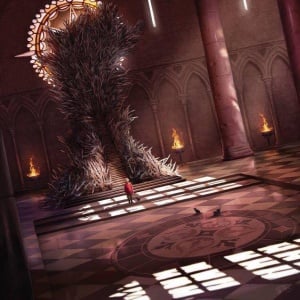
Following the murder of Tywin by Tyrion, Cersei holds the Iron Throne as regent on behalf of her son, the young Tommen. Cersei has a dream of herself sitting the Iron Throne which turns into a nightmare.[74] Cersei refuses to allow Tommen to sit on the sharp throne.[75] As she is not the monarch or the Hand of the King, Cersei rules from a gold-and-crimson high seat beneath the Iron Throne.[76]
Princess Arianne Martell plots to crown Princess Myrcella Baratheon, Tommen's older sister, on the Iron Throne as queen. The plot falters at the Greenblood, however.[77] Euron Greyjoy, chosen as Balon's successor as King of the Isles and the North at the kingsmoot, plans to conquer all of Westeros and claim the Iron Throne.[78]
After Cersei re-establishes the Faith Militant, she is arrested by the Faith of the Seven for various crimes. Her uncle Kevan Lannister becomes regent in her place.[79]
A Dance with Dragons
Tommen continues to hold the Iron Throne under the regency of his grand-uncle, Ser Kevan Lannister,[80] but Stannis still maintains his claim even while in the north.[81]
The exiled Lord Jon Connington leads the landing of the Golden Company in the stormlands. The sellswords plot to place Aegon VI Targaryen on the throne.[82] Kevan and Grand Maester Pycelle are murdered by Varys, a supporter of Aegon, at the Red Keep.[83]
Monarchy
Succession

Inheritance customs for the Iron Throne differ from the inheritance customs in the rest of the Seven Kingdoms. Generally, like elsewhere in the kingdom, male-preference primogeniture is customary. Aenys, the eldest son of King Aegon I, the first king on the Iron Throne, was considered Aegon's clear successor. The birth of Aenys's first child, Rhaena, brought forth the question as to who should stand next in line following Aenys: his daughter Rhaena, or his younger brother Maegor? The birth of Aenys's son Aegon settled the discussion of who should succeed Aenys, although it was not concluded whether Rhaena or Maegor stood earlier in the line of succession.[13]
After Aenys died, his brother Maegor took the throne by force, ignoring the claim of Aenys's son Aegon. Following Aegon's death, his wife Rhaena feared for the safety of their eldest daughter, Aerea, who stood Aegon's heir by the laws of the Seven Kingdoms. Aerea was eventually appointed as Maegor I's heir, until he would have a son of his own.[13] However, Maegor the Cruel died childless, and several claims were discussed. As the only surviving son of the late King Aenys I, Jaehaerys Targaryen's claim was strong. However, his elder brother Aegon had claimed the throne before him, and if he were to be considered to have been the true king, the throne should pass to his eldest child, Aerea. Some even suggested that the claim of Princess Rhaena, as Aenys I's eldest child, was the strongest of them all. However, Aerea and her younger twin were discounted on account of their sex and young age, and Rhaena on account of her sex alone. As a result, Jaehaerys ascended the Iron Throne.[84]
Jaehaerys I named his niece Aerea as his heir as well,[22][23] a position she held for five years (with the exception of three days during 52 AC), until the birth of Princess Daenerys in 53 AC.[24] The title of heir apparent was given to Prince Aemon following his birth two years later,[25] upsetting Queen Alysanne Targaryen.
Aemon remained heir to the throne until his own death in battle in 92 AC. Aemon's death caused a crisis in the succession, as his only issue was a daughter, Rhaenys. Rhaenys was pregnant upon the death of her father, and when Jaehaerys appointed Aemon's brother Baelon over Rhaenys, Rhaenys proclaimed that the king had not only passed over her, but also her "unborn son". Upon Baelon's death in 101 AC, Jaehaerys followed the advice of his only surviving son Vaegon and called the first Great Council. There, fourteen claims were considered. Nine lesser claims were dismissed, including those of a man claiming descent from Lord Gaemon Targaryen through a daughter; three bastard grandsons of King Jaehaerys through his daughter Saera; a man claiming to be a bastard son of Maegor I; a hedge knight claiming to be a bastard son of King Jaehaerys; Archmaester Vaegon, Jaehaerys's only remaining son; Princess Rhaenys Targaryen, Jaehaerys's grandchild through his eldest son, Aemon; and Laena Velaryon, Rhaenys's eldest child. The two claims that remained belonged to Laenor Velaryon, Rhaenys's son, and Viserys Targaryen, the eldest son of Prince Baelon. As Laenor descended from the king through the king’s eldest son, primogeniture favored him, but proximity favored Viserys, as Viserys was the king’s grandson, while Laenor was his great-grandson. Laenor's young age spoke against him, however, and the lords present voted for Viserys over Laenor twenty to one. Many felt that a male line was preferred over a female line, and believed that the decision of the Great Council set a precedent stating that the Iron Throne could not pass to a woman, or to the male descendants of a woman.[85][10]
Ironically, it was Prince Viserys, by then crowned king, who disregarded these precedents in 105 AC by naming his daughter and only remaining child at the time, Rhaenyra Targaryen, as his heir. Despite the birth of three healthy sons during his second marriage in the years that followed, Viserys remained intent that Rhaenyra should succeed him.[86] Viserys's decision would eventually lead to the civil war known as the Dance of the Dragons, where his eldest son Aegon II Targaryen claimed the throne, ignoring Rhaenyra’s status as heir. During the war, Aegon II's sons, Jaehaerys and Maelor, died, as did Rhaenyra's eldest three sons (Jacaerys, Lucerys, and Joffrey Velaryon), while her youngest son, Prince Viserys, was presumed dead.[87][88] In an attempt to end the war, Lord Corlys Velaryon ensured that Aegon II's only remaining heir, his daughter Jaehaera, was betrothed to Rhaenyra's son, Aegon the Younger, and that both were named Aegon II's heirs.[28] Following Aegon II’s death, Aegon III was crowned.
The agnatic principle laid down in the Great Council of 101 AC was slightly modified after the Dance of the Dragons. Thereafter, according to a semi-canon source, women came after all men in the Targaryen succession,[89] i.e., women could only succeed if the entire male line of House Targaryen became extinct. Nonetheless, several females claims have since been considered. In 171 AC, following the deaths of Aegon III's sons Daeron I and Baelor I, both childless, the claims of Aegon's three daughters were considered. However, with the Dance of the Dragons still fresh in their minds, the claims of the three women were passed over and Aegon's brother Viserys II ascended the throne.[34] Another few decades later, King Maekar I Targaryen died without a clearly established heir. His simple-minded granddaughter Vaella Targaryen, the only child of Maekar's eldest son, was seen as a possible claimant. However, her claim was quickly dismissed.[41][55]
In 283 AC, the Sack of King's Landing during Robert's Rebellion led to the death of King Aerys II Targaryen. His sister-wife, Queen Rhaella Targaryen, pregnant with Princess Daenerys, was at Dragonstone with Aerys's surviving son, Prince Viserys, who was declared king on the island fortress.[90] Robert I Baratheon, however, acceded the Iron Throne by right of conquest,[91] chosen as claimant by the rebels due to his Targaryen descent,[92] as he was the grandson of Princess Rhaelle Targaryen, the youngest daughter of King Aegon V Targaryen,[93] which gave him the better claim among the rebels. Nonetheless, the exiled Viserys declared his sister Daenerys his heir, naming her Princess of Dragonstone,[52] and following Viserys's death, Daenerys has declared her own claim for the Iron Throne.[65]
List of Kings
The following kings have ruled the Seven Kingdoms with the Iron Throne as their seat:
Gallery
- Kings on the Iron Throne
Rival Kings and Claimants to the Iron Throne
- 42–43 AC: Aegon Targaryen, eldest son of Aenys I Targaryen and his rightful heir, laid claim to the throne after his uncle Maegor I Targaryen took it. He was killed by his uncle in the Battle Beneath the Gods Eye.
- 129–130 AC: Rhaenyra Targaryen, also known as "the Realm's Delight", Princess of Dragonstone, the named heir to Viserys I Targaryen; her succession was challenged by her half-brother, Aegon II Targaryen. This led to the civil war known as the Dance of the Dragons.
- 130 AC: Trystane Truefyre, alleged bastard son of Viserys I Targaryen, during the Moon of the Three Kings.
- 130 AC: Gaemon Palehair, alleged bastard son of Aegon II Targaryen and a whore, during the Moon of the Three Kings.
- 130 AC: Hugh Hammer, a dragonseed, openly declared to the Greens his intention to sit the Iron Throne and started to wear a crown. However, he was killed by Ser Jon Roxton while he was preparing for the Second Battle of Tumbleton.
- 196 AC: Daemon I Blackfyre, the first of the Blackfyre Pretenders, trying to claim the throne during the First Blackfyre Rebellion.
- 212 AC: Daemon II Blackfyre, plotting to claim the throne during the Second Blackfyre Rebellion. The second of the Blackfyre Pretenders.
- 219 AC: Haegon I Blackfyre, trying to claim the throne during the Third Blackfyre Rebellion. The third of the Blackfyre Pretenders.
- 236 AC: Daemon III Blackfyre, trying to claim the throne during the Fourth Blackfyre Rebellion. The fourth of the Blackfyre Pretenders.
- 260 AC: Maelys I Blackfyre, trying to claim the throne during the War of the Ninepenny Kings. The fifth and last of the Blackfyre Pretenders.
- 283–298 AC: Viserys Targaryen, the Beggar King, styling himself as Viserys III Targaryen; killed by the Dothraki for violating the laws of Vaes Dothrak.
- 298 AC – Present: Daenerys Targaryen, the Stormborn, Mother of Dragons, Queen of Meereen, Khaleesi of the Great Grass Sea.
- 298–299 AC: Renly I Baratheon, Lord of Storm's End; killed by a shadow.
- 299 AC – Present: Stannis I Baratheon, Lord of Dragonstone.
- 300 AC: Myrcella Baratheon was taken by Arianne Martell as part of a plan to crown her queen of the Seven Kingdoms. This plan was quickly foiled by Arianne's father, Prince Doran.
- 300 AC – Present: Aegon Targaryen, the allegedly living son of the late Prince Rhaegar Targaryen.
Family tree
This tree only contains kings, queens and claimants for the Iron Throne, as well as a few others that link them.
Quotes about the Iron Throne
I swear to you, sitting a throne is a thousand times harder than winning one.[53]
—Jeor Mormont to Jon Snow
They can keep their red castle and their iron chair as well.[61]
Tell me, what right did my brother Robert ever have to the Iron Throne? Oh, there was talk of the blood ties between Baratheon and Targaryen, of weddings a hundred years past, of second sons and elder daughters. No one but the maesters care about any of it. Robert won the throne with his warhammer.[91]
This Iron Throne you speak of sounds monstrous cold and hard. I cannot bear the thought of jagged barbs cutting your sweet skin.[65]
Jorah: When Aegon the Dragon stepped ashore in Westeros, the kings of Vale and Rock and Reach did not rush to hand him their crowns. If you mean to sit his Iron Throne, you must win it as he did, with steel and dragonfire. And that will mean blood on your hands before the thing is done.
Daenerys: The blood of my enemies I will shed gladly. The blood of innocents is another matter.[96]
Stannis: Have you ever seen the Iron Throne? The barbs along the back, the ribbons of twisted steel, the jagged ends of swords and knives all tangled up and melted? It is not a comfortable seat, ser. Aerys cut himself so often men took to calling him King Scab, and Maegor the Cruel was murdered in that chair. By that chair, to hear some tell it. It is not a seat where a man can rest at ease. Ofttimes I wonder why my brothers wanted it so desperately.
Davos: Why would you want it, then?
Stannis: It is not a question of wanting. The throne is mine, as Robert's heir. That is law.[11]
By the end the Mad King had become so fearful that he would allow no blade in his presence, save for the swords his Kingsguard wore. His beard was matted and unwashed, his hair a silver-gold tangle that reached his waist, his fingernails cracked yellow claws nine inches long. Yet still the blades tormented him, the ones he could never escape, the blades of the Iron Throne. His arms and legs were always covered with scabs and half-healed cuts.[97]
—Jaime Lannister's thoughts
I will claim the Iron Throne by myself, with your swords and your allegiance.[99]
—Aegon Targaryen to the Golden Company
Behind the Scenes
George R. R. Martin intends the Iron Throne to be intimidating. In an interview, he referenced Percy Bysshe Shelley's poem "Ozymandias": 'Look on my works, ye Mighty, and despair!'[100]
References
- ↑ 1.0 1.1 1.2 1.3 Not a Blog: The Real Iron Throne (Jul. 8th, 2013)
- ↑ 2.0 2.1 Fire & Blood, The Long Reign - Jaehaerys and Alysanne - Policy, Progeny, and Pain.
- ↑ 3.0 3.1 A Clash of Kings, Chapter 25, Tyrion VI.
- ↑ A Feast for Crows, Chapter 24, Cersei V.
- ↑ 5.0 5.1 Fire & Blood, Three Heads had the Dragon - Governance Under King Aegon I.
- ↑ 6.0 6.1 6.2 Fire & Blood, The Dying of the Dragons - The Red Dragon and the Gold.
- ↑ 7.00 7.01 7.02 7.03 7.04 7.05 7.06 7.07 7.08 7.09 7.10 7.11 A Game of Thrones, Chapter 43, Eddard XI.
- ↑ Fire & Blood, Aegon's Conquest.
- ↑ 9.0 9.1 9.2 9.3 The World of Ice & Fire, The Reign of the Dragons: The Conquest.
- ↑ 10.0 10.1 10.2 10.3 Fire & Blood, Heirs of the Dragon - A Question of Succession.
- ↑ 11.0 11.1 11.2 11.3 A Storm of Swords, Chapter 36, Davos IV.
- ↑ 12.0 12.1 The World of Ice & Fire, The Targaryen Kings: Aerys II.
- ↑ 13.0 13.1 13.2 13.3 13.4 13.5 13.6 Fire & Blood, The Sons of the Dragon.
- ↑ The World of Ice & Fire, The Targaryen Kings: Aegon I.
- ↑ 15.0 15.1 Fire & Blood, Reign of the Dragon - The Wars of King Aegon I.
- ↑ Fire & Blood, The Long Reign - Jaehaerys and Alysanne: Policy, Progeny, and Pain.
- ↑ The World of Ice & Fire, The Targaryen Kings: Daeron I.
- ↑ The World of Ice & Fire, The Targaryen Kings - Aegon I.
- ↑ The World of Ice & Fire, The Targaryen Kings: Aenys I.
- ↑ 20.0 20.1 The World of Ice & Fire, The Targaryen Kings: Maegor I.
- ↑ Fire & Blood, Prince into King - The Ascension of Jaehaerys I.
- ↑ 22.0 22.1 Fire & Blood, The Year of the Three Brides - 49.
- ↑ 23.0 23.1 Fire & Blood, A Time of Testing - The Realm Remade.
- ↑ 24.0 24.1 Fire & Blood, Birth, Death, and Betrayal Under King Jaehaerys I.
- ↑ 25.0 25.1 Fire & Blood, Jaehaerys and Alysanne - Their Triumphs and Tragedies.
- ↑ Fire & Blood, The Heirs of the Dragon - A Question of Succession.
- ↑ Fire & Blood, The Dying of the Dragons - Rhaenyra Overthrown.
- ↑ 28.0 28.1 28.2 28.3 Fire & Blood, The Dying of the Dragons - The Short, Sad Reign of Aegon II.
- ↑ 29.0 29.1 Fire & Blood, Aftermath - The Hour of the Wolf.
- ↑ Fire & Blood, Under the Regents - The Hooded Hand.
- ↑ The World of Ice & Fire, The Targaryen Kings: Aegon III.
- ↑ 32.0 32.1 Fire & Blood, Under the Regents - War and Peace and Cattle Shows.
- ↑ The World of Ice & Fire, The Targaryen Kings: Baelor I.
- ↑ 34.0 34.1 The World of Ice & Fire, The Targaryen Kings: Viserys II.
- ↑ 35.0 35.1 The World of Ice & Fire, The Targaryen Kings: Aegon IV.
- ↑ The World of Ice & Fire, The Targaryen Kings: Daeron II.
- ↑ 37.0 37.1 37.2 37.3 The World of Ice & Fire, The Targaryen Kings: Aerys I.
- ↑ 38.0 38.1 The World of Ice & Fire, The Targaryen Kings: Aegon V.
- ↑ The World of Ice & Fire, The Targaryen Kings: Jaehaerys II.
- ↑ asoiaf.westeros.org: R+L=J v. 164 – Comment by Ran (December 12, 2017)
- ↑ 41.0 41.1 41.2 41.3 The World of Ice & Fire, The Targaryen Kings: Maekar I.
- ↑ The World of Ice & Fire, The Westerlands: House Lannister Under the Dragons.
- ↑ The World of Ice & Fire, The Targaryen Kings: Jaehaerys V.
- ↑ A Clash of Kings, Chapter 55, Catelyn VII.
- ↑ 45.0 45.1 The World of Ice & Fire, The Fall of the Dragons: Robert's Rebellion.
- ↑ 46.0 46.1 A Storm of Swords, Chapter 11, Jaime II.
- ↑ A Storm of Swords, Chapter 37, Jaime V.
- ↑ 48.0 48.1 48.2 48.3 A Game of Thrones, Chapter 12, Eddard II.
- ↑ A Storm of Swords, Chapter 53, Tyrion VI.
- ↑ 50.0 50.1 A Game of Thrones, Chapter 45, Eddard XII.
- ↑ A Storm of Swords, Chapter 66, Tyrion IX.
- ↑ 52.0 52.1 A Game of Thrones, Chapter 3, Daenerys I.
- ↑ 53.0 53.1 53.2 A Game of Thrones, Chapter 4, Eddard I.
- ↑ A Game of Thrones, Chapter 33, Eddard VIII.
- ↑ 55.0 55.1 A Clash of Kings, Chapter 6, Jon I.
- ↑ 56.0 56.1 56.2 A Game of Thrones, Chapter 20, Eddard IV.
- ↑ The World of Ice & Fire, The Iron Islands: The Old Way and the New.
- ↑ A Game of Thrones, Chapter 51, Sansa IV.
- ↑ 59.0 59.1 A Game of Thrones, Chapter 57, Sansa V.
- ↑ A Game of Thrones, Chapter 69, Tyrion IX.
- ↑ 61.0 61.1 A Game of Thrones, Chapter 71, Catelyn XI.
- ↑ A Clash of Kings, Chapter 10, Davos I.
- ↑ A Clash of Kings, Chapter 2, Sansa I.
- ↑ A Clash of Kings, Chapter 20, Tyrion V.
- ↑ 65.0 65.1 65.2 A Clash of Kings, Chapter 40, Daenerys III.
- ↑ A Clash of Kings, Chapter 33, Catelyn IV.
- ↑ A Clash of Kings, Chapter 37, Theon III.
- ↑ A Clash of Kings, Chapter 62, Sansa VII.
- ↑ A Clash of Kings, Chapter 65, Sansa VIII.
- ↑ A Storm of Swords, Chapter 45, Catelyn V.
- ↑ A Storm of Swords, Chapter 51, Catelyn VII.
- ↑ A Storm of Swords, Chapter 60, Tyrion VIII.
- ↑ A Storm of Swords, Chapter 70, Tyrion X.
- ↑ A Feast for Crows, Chapter 3, Cersei I.
- ↑ A Feast for Crows, Chapter 25, Brienne V.
- ↑ A Feast for Crows, Chapter 32, Cersei VII.
- ↑ A Feast for Crows, Chapter 21, The Queenmaker.
- ↑ A Feast for Crows, Chapter 29, The Reaver.
- ↑ A Feast for Crows, Chapter 43, Cersei X.
- ↑ A Dance with Dragons, Chapter 54, Cersei I.
- ↑ A Dance with Dragons, Chapter 17, Jon IV.
- ↑ A Dance with Dragons, Chapter 61, The Griffin Reborn.
- ↑ A Dance with Dragons, Appendix.
- ↑ Fire & Blood, Prince into King – The Ascension of Jaehaerys I.
- ↑ The World of Ice & Fire, The Targaryen Kings: Jaehaerys I.
- ↑ The World of Ice & Fire, The Targaryen Kings: Viserys I.
- ↑ The Princess and the Queen.
- ↑ The World of Ice & Fire, The Targaryen Kings: Aegon II.
- ↑ So Spake Martin: Comic Con San Diego (July 23, 2006)
- ↑ George R. R. Martin's A World of Ice and Fire, Rhaella Targaryen.
- ↑ 91.0 91.1 A Clash of Kings, Chapter 22, Catelyn II.
- ↑ A Game of Thrones, Chapter 30, Eddard VII.
- ↑ A Feast for Crows, Chapter 35, Samwell IV.
- ↑ A Game of Thrones, Chapter 47, Eddard XIII.
- ↑ A Game of Thrones, Chapter 70, Jon IX.
- ↑ A Storm of Swords, Chapter 23, Daenerys II.
- ↑ A Feast for Crows, Chapter 16, Jaime II.
- ↑ A Dance with Dragons, Chapter 5, Tyrion II.
- ↑ A Dance with Dragons, Chapter 24, The Lost Lord.
- ↑ 92nd Street Y: Game of Thrones Mastermind George R. R. Martin: The World of Ice and Fire, Oct 26, 2014
